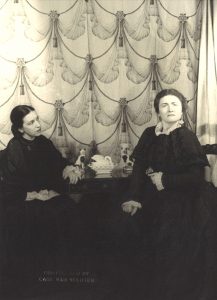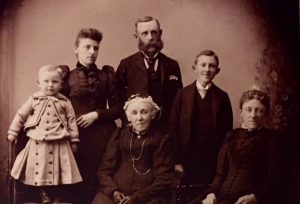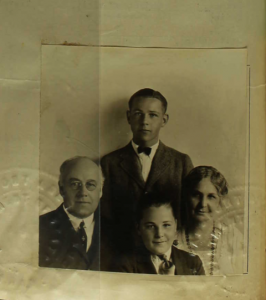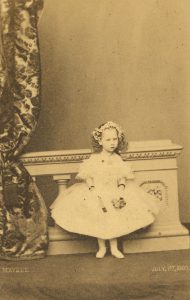After my photo album puzzle was solved within what seemed like minutes of being posted (thank you, everyone!), I did some quick research: Monhegan records around 1900 contained none of my husband’s family names. Seems likely his ancestor was just another visitor to the island – a tourist who was also a talented photographer, or who appreciated the skills of a photographer who, like many artists, was drawn to the beauty of Monhegan. Still, the images in the little album drew me in. I wanted to know more about this island situated twelve nautical miles off the coast of Boothbay, Maine. Continue reading Monhegan puzzle pieces
Tag Archives: Photographs
Artistic imposture

The recent acquisition of a 1947 photograph of the mezzo-soprano Dorothy Dow playing Susan B. Anthony[1] made me think about how historic figures have been represented on stage and in film – and, thus, in the still photographs that capture moments in these productions. In most cases, inevitably, the production choices reflect the date of the production as much as the purported date of the action. This example, by Carl Van Vechten, tells us as much about Van Vechten as it does Susan B. Anthony. While the setting is presumably the stage set for a scene in the opera, the lighting and even the backdrop belong in the photographer’s own studio. Continue reading Artistic imposture
The hidden face

My questions about him had been endless. He was, after all, the phantom in my ancestry, a great and impervious vapor, a Wizard of Oz if you will. He was my fleeting great-grandfather, the drawn curtain of my pedigree chart, his family lines going, well … nowhere. I don’t know that I ever really expected to find him, or to see his face. I certainly did not expect any DNA results to fall from the sky, making a picture of his smile even possible. Yet those DNA results did pull back the curtain (coming in just last week) and therein I was able to find his face, albeit grainy in brown and white, and sheepishly grinning down and away, as if to say he knew I’d been looking for him for a very, very long time. Indeed, I had been. Continue reading The hidden face
A photographic puzzle
 Our house has lots of dusty boxes that came from the houses of deceased family members. There’s the box of stuff from my father’s bachelor brother, William “Bud” Buzzell, who served on an LST during World War II and who sold me my first car for a dollar. There are several boxes from my mother’s mother, Thelma Jane MacLean, about whose Telluride parents I have written before.
Our house has lots of dusty boxes that came from the houses of deceased family members. There’s the box of stuff from my father’s bachelor brother, William “Bud” Buzzell, who served on an LST during World War II and who sold me my first car for a dollar. There are several boxes from my mother’s mother, Thelma Jane MacLean, about whose Telluride parents I have written before.
Not to be outdone by my family’s packrat tendencies, we also have boxes from my husband Scott’s Inglis, Milne, Munroe, and MacCuish ancestors. The Inglis family hailed from Galashiels, south of Edinburgh; the Milnes were from Inverness in the Scottish Highlands. The Munroes left Scotland to settle in Cape Breton, Nova Scotia. We believe the MacCuishes emigrated from the island of North Uist in Scotland’s Outer Hebrides to Newfoundland. Continue reading A photographic puzzle
Additions and corrections
 I love it when other genealogists give me a hand. This past weekend someone from San Diego kindly alerted me to an eBay auction for an old Imperial Cabinet-sized photograph. Someone had thoughtfully labeled the people in the photograph years ago, and they all appear in my online family tree (though none as a close relation). Continue reading Additions and corrections
I love it when other genealogists give me a hand. This past weekend someone from San Diego kindly alerted me to an eBay auction for an old Imperial Cabinet-sized photograph. Someone had thoughtfully labeled the people in the photograph years ago, and they all appear in my online family tree (though none as a close relation). Continue reading Additions and corrections
Royal cartes de visite: Part Three
[This series on royal cartes de visite began here.]

Queen Victoria and Prince Albert viewed Prussia as their ideal among the multitude of German kingdoms, principalities, and duchies. Early on in their marriage, they hoped that the son of their friends the Prince and Princess of Prussia – the former the heir presumptive to the kingdom – might someday marry their eldest daughter, Vicky, as Prince Frederick William duly did, in 1858, when the bride was just seventeen.
Fritz and Vicky were happy as a couple, but the friendly alliance of Great Britain and Prussia (from 1871 the nucleus of the German Empire) did not play out quite as the bride’s parents had expected. Instead of a liberal Germany presiding over the restless nations in eastern Europe, the British court watched in surprise as the comparatively progressive Prince of Prussia became the conservative Kaiser Wilhelm I and the once-obscure Prussian diplomat Otto von Bismarck became all-powerful at the courts of Wilhelm I (1871–88), Friedrich III (1888), and then Wilhelm II (1888–1918). Continue reading Royal cartes de visite: Part Three
By any other name
 Sometimes I wonder why my husband and I even maintain a landline telephone. It seems to be used almost exclusively by telemarketers … including the scammer from “Technical Support” who called me twice at 11:00 p.m. this past week! Every once in a while it proves its value, though, such as the time last November when I received a call from an unknown woman in Berkeley, California, asking whether I had a grandmother or great-grandmother named Purle. Continue reading By any other name
Sometimes I wonder why my husband and I even maintain a landline telephone. It seems to be used almost exclusively by telemarketers … including the scammer from “Technical Support” who called me twice at 11:00 p.m. this past week! Every once in a while it proves its value, though, such as the time last November when I received a call from an unknown woman in Berkeley, California, asking whether I had a grandmother or great-grandmother named Purle. Continue reading By any other name
Royal cartes de visite: Part Two
[This series on royal cartes de visite began here.]

Prince Albert of Saxe-Coburg-Gotha was created Prince Consort in 1857, the year his youngest child – Princess Beatrice – was born. When the Prince Consort died in 1861, his eldest child (the Crown Princess of Prussia) was just 21, while Beatrice (shown here in 1860) was four years old.
For the younger children of Queen Victoria and Prince Albert, their father receded from life and into legend. The mercurial Beatrice, an enchanting child, became a stately matron in her mother’s mold; her elder brother Arthur achieved distinction in the Army, while Leopold – who inherited his mother’s family’s strain of hemophilia – died young; Helena and Louise, so similar as young women, grew up to take different paths. Continue reading Royal cartes de visite: Part Two
Intermissions

This past Christmas weekend I was re-introduced to a medium of family history that may have gone out of style. No, I’m not talking about my own use of outdated published materials (yikes!) or any of my attempted genealogical gleanings (snore…) or even my possible faux pas in giving dad a DNA test for Christmas.
Rather, I am referring to a medium of family history generally associated with oral histories and a medium where we (almost…) never actually hear anyone speak! Continue reading Intermissions
Royal cartes de visite

As a collector of photographs, I am drawn to faces: the hints of personality in an unflinching gaze or a sidelong glance. Periodically I find myself haring off in a new direction, and this latest detour is perhaps unsurprising: I’ve started collecting royal cartes de visite, with a focus on the family of Queen Victoria and her -in-laws. (Just in time for the royal engagement, in fact!)
There is something pleasing about Queen Victoria and her family: it is large enough, complex enough, and far-flung enough to be a challenge. (I am still working on some of the sons- and daughters-in-law – I only just reached the full complement of Victoria’s nine children.) In these images, one can see the distinctive Hanoverian and Coburger physiognomies, as divided up between the offspring of Victoria and Albert. In the following images there is even the hint of the modern royal look, in Princess Louis of Hesse’s infant daughter, Victoria, later Princess of Battenberg and then Marchioness of Milford Haven – and the grandmother of Prince Philip, Duke of Edinburgh. Continue reading Royal cartes de visite
